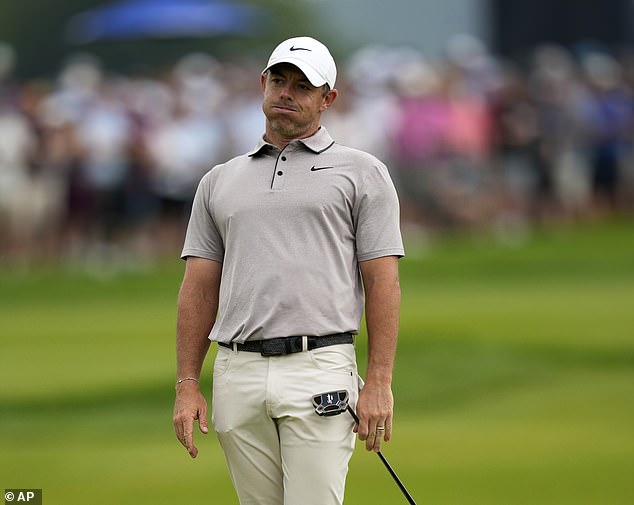Rory McIlroy’s Media Standoff: A Deep Dive into Recent Controversies and Professional Golf’s Media Dynamics
Rory McIlroy, a towering figure in professional golf, has recently made headlines—not just for his athletic prowess but for his complex relationship with the media. Following a series of events during the PGA Championship and his subsequent appearances, McIlroy’s behavior raised eyebrows and sparked debate among sports enthusiasts and media alike. His frustration with the reporting of a failed legality test on his driver, coupled with his decision to skip media obligations, has brought the issue of player-journalist dynamics to the forefront.
The Leaked Report: McIlroy’s Driver Controversy
In early June 2025, it was reported that McIlroy’s driver may have failed a legality test during the prestigious PGA Championship. This news did not sit well with the golfer, who openly expressed his annoyance at the way the situation was handled. For McIlroy, the integrity of his equipment is critical to his performance, and any insinuation to the contrary can significantly impact a player’s reputation. His reaction not only highlighted the intense scrutiny athletes face but also raised questions about journalistic standards in covering sports equipment violations.
Skipping the Media: McIlroy’s Defiant Stance
McIlroy’s decision to snub multiple media requests during the PGA Championship ignited criticism. He felt justified in his actions, having stated that professional golfers "are well within our rights" to manage their media appearances as they see fit. The golfer didn’t shy away from expressing his right to prioritize his mental well-being rather than succumb to the pressure of fulfilling media obligations after a taxing tournament.
Responses to Criticism: Reaffirming His Choices
Addressing the fallout from his media silence, McIlroy cut a defiant figure at the US Open. In a candid exchange, he articulated, "I feel like I’ve earned the right to do whatever I want." This statement encapsulated his mindset following a significant achievement in his career—the completion of the Grand Slam at the Masters. McIlroy’s assertions highlight a growing trend where athletes question the traditional expectations of media interaction.
Navigating a New Media Landscape
The landscape of sports media is evolving rapidly, and McIlroy is acutely aware of these shifts. He acknowledges that the modern athlete has multiple avenues to communicate with fans, such as social media platforms, which can sometimes render traditional media interviews less necessary. "There are so many ways to consume sports and entertainment," he remarked, pointing out the need to adapt to the changing dynamics of fan engagement and sports reporting.
Player Relationships with the Media: A Two-Way Street
In his remarks during the Travelers Championship, McIlroy emphasized the importance of reciprocal respect between players and journalists. He pointed out that while he respects the role of the media in sports, it is equally critical for media outlets to consider the needs and wishes of athletes. "This is a two-way street," he said, indicating that both sides must navigate this relationship with understanding and cooperation.
The Burden of Responsibility: Golf’s Media Protocol
McIlroy also touched upon the existing media protocols in golf, expressing his thoughts on their implications for player conduct. "If [golf officials] want to make it mandatory, that’s fine," he noted, referring to potential rules requiring players to engage with the press. Until such changes are implemented, he asserted that players maintain the right to skip media interactions without repercussions.
Understanding the Athlete’s Perspective
The media scrutiny surrounding athletes can be overwhelming, and McIlroy articulated this sentiment when discussing the mental toll it can take. By choosing to excuse himself from media obligations, he aimed to focus on his game and personal well-being. McIlroy’s stance serves as an important reminder of the pressures athletes face, prompting a dialogue on the balance between media access and player wellness.
The Future of Media in Sports
As sports fans witness changes in player-media dynamics, the future holds intriguing possibilities. McIlroy’s recent statements suggest a shift toward a more player-centric media strategy, one that aligns with modern consumption trends in sports. This could pave the way for other athletes to feel empowered to control their narratives and decide how they wish to engage with the media.
Conclusion: McIlroy’s Legacy beyond the Golf Course
In the grand tapestry of Rory McIlroy’s career, these recent developments will undoubtedly contribute to his legacy as an athlete who advocated for the modern player’s voice. By exercising his right to navigate media engagements on his terms, he has sparked a necessary conversation about the evolving role of journalists in sports and the importance of considering athletes’ perspectives in an era defined by rapid digital change.
As McIlroy continues to compete at the highest levels, both his performance and his approach to media relations will serve as critical touchpoints for discussions about the future of sports journalism and player autonomy. Whether he faces scrutiny or applause, one thing is clear—McIlroy is committed to living life on his terms, both on and off the golf course.


